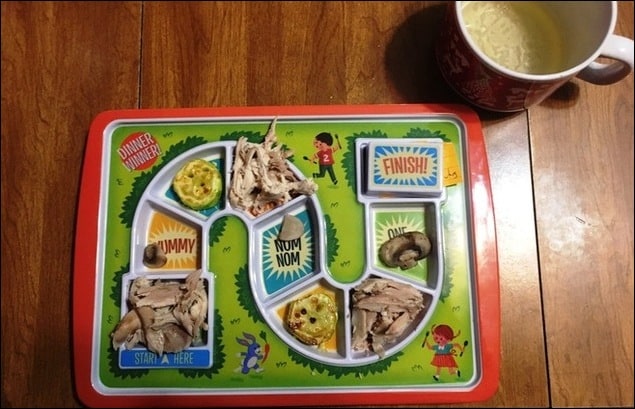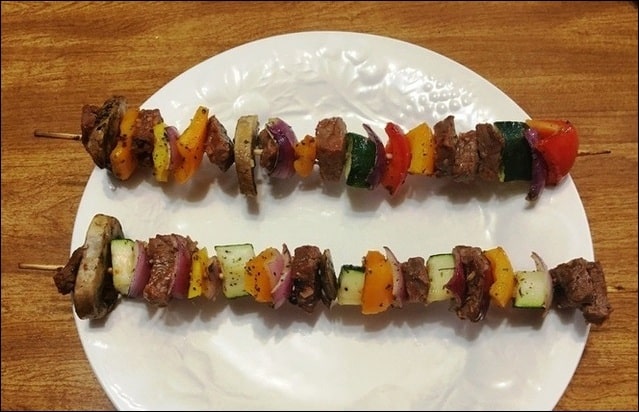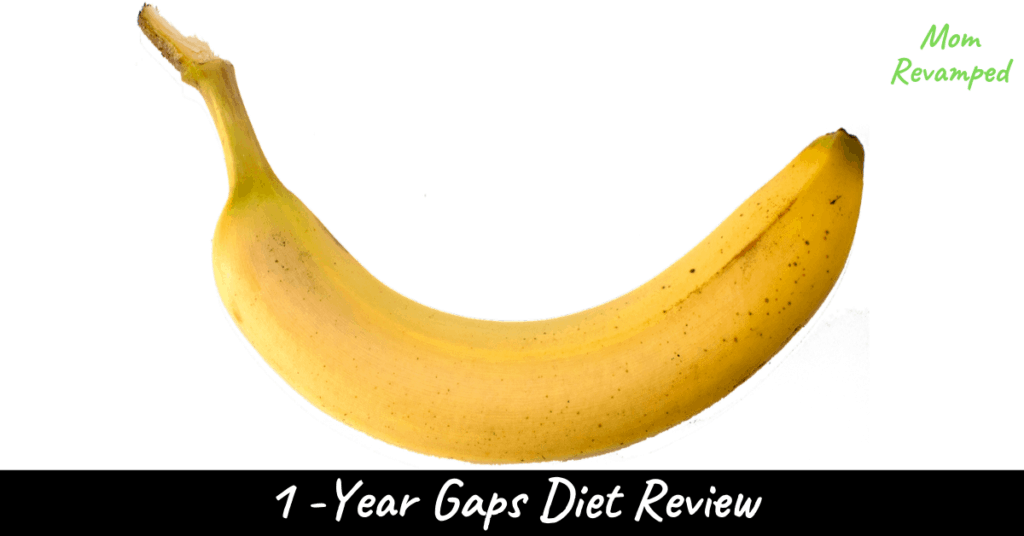This post may contain affiliate links. As an Amazon Associate I earn from qualifying purchases. If you click on the link and make a purchase I receive small commission (at no extra cost to you!), which helps fund the Mom Revamped Site.

Last summer my family and I did the GAPS diet for a month to help make the transition to this diet full time easier for my oldest daughter.
Before we started, I read through a lot of blog posts looking for GAPS diet success stories for autism. I read a lot of GAPS diet reviews from people who were treating other symptoms too.
I never started this diet hoping to see some kind of GAPS diet autism recovery miracle. I have long gotten past the idea that autism could be cured.
My motivation for this diet was just to help Big Sis with her digestive issues, but I did watch to see if there were improvements in any of her autism symptoms too.
I’ve already posted about what my experience on the GAPS intro diet was and why my kids experience with it led us to quit intro and just do the Full GAPS diet instead.
I have also posted about my experience with the keto diet and why I ended up quitting keto.
Now that Big Sis has been following the diet for a year, I thought it was time to give my full GAPS diet review and share our experience with the GAPS diet for autism.
What is the GAPS Diet?
The GAPS diet is a strict protocol that treats leaky gut and has been used to improve symptoms of autism, ADHD, dyslexia, schizophrenia, bipolar disorder, OCD, and depression, as well as digestive conditions like crohn’s, ulcerative colitis , and inflammatory bowel disease.
The GAPS diet is a variation of the SCD diet (Specific Carbohydrate Diet), which was made popular by Elaine Gottschall who healed her daughters ulcerative colitis and wrote the book Breaking the Vicious Cycle to help others learn how to follow the diet.
10 years later, Dr. Natasha Campbell McBride released the book Gut and Psychology Syndrome, about the diet she created with adjustments to SCD based on her own research.
While both diets aim to heal the gut by eliminating hard to digest food, the GAPS diet also focuses on ensuring you eat broth and fermented foods every day, as well as taking supplements, such as probiotics and fish oil, to help the healing process.
Unlike SCD, the GAPS diet is also broken down into stages to introduce food in.
How long it takes to get through each stage of the GAPS diet is different for each person, as you are supposed to wait until digestive symptoms clear before moving to the next stage.
While someone with minor digestive issues could get through all 6 GAPS diet stages in under two months, those with more severe symptoms may need to be on the intro diet longer.
Why We Started GAPS
Big Sis has had digestive problems her whole life.
As a baby, she constantly spit up, to the point that she had to wear a bib full time and we had to tear out our carpets by the time she was two. Even as she moved beyond that baby phase, she continued to regurgitate her food.
She also suffered from constant diarrhea until she was two.
That was when we put her on a gluten-free, casein-free, soy-free diet (and a year later added corn free too). Her diarrhea cleared right up, and for the first time in her life, she was having solid bowel movements.
Not only did her digestive issues clear up, but we also saw improvements in some of her autism symptoms. Suddenly she was more aware of the world around her, as if the bubble she had lived in had popped. We saw gains in her speech and her pretend play skills too.
But 9 years later I realized that her digestive issue had slowly returned.
Not knowing what other food I could eliminate, I remembered reading about both the GAPS diet and SCD years earlier.
While back then it had seemed like it would be too hard to follow, at this point, I didn’t see any other way to help Big Sis stop suffering from constipation, gas pains and now constant regurgitation.
So, after reading the book and making a GAPS diet food list with things my kids might be willing to eat, I came up with my own GAPS diet plan to get us adjusted to this diet before the kids had to go back to school.
Does GAPS Diet Cure Digestive Symptoms?
Since I have already posted about the GAPS diet for kids, I won’t go over how hard it was to transition to this diet for a kid with autism again.
Despite the difficulty of starting the diet, we did see improvements in Big Sis’s digestive issue right away.
Within a couple of days of being on the diet, her regurgitation had stopped.
It was a bit harder to monitor her constipation symptoms in the beginning since she was pretty much refusing to eat anything, but once she was back to eating as much as usual, there were no more issues with constipation, or bad gas, either.
When we started her on the recommended Biokult probiotic she did have some diarrhea, but once I realized that starting her on the full dose was too much it cleared up. We were able to slowly increase her probiotic dose to the full amount without any more poop problems.
Does Gaps Diet Cure Autism?

Like I said earlier, I didn’t have too many expectations for the diet to “cure” her autism, but we did see some improvements in a couple of areas initially.
The first week of the diet there was some improvement to her speech.
While she always mixes up the pronouns “I” and “you”, she got it right when she said, “I don’t like the chicken”. She also was able to formulate a full sentence to ask me “mom, what is this”, instead of saying her usual “this is?”
There were also some improvements in her ability to process her thoughts and put them into words.
While she had struggled to find the words to tell us she didn’t know what she wanted for her birthday, instead just saying “no” when we asked, she was able to say “mom, I want to go to the store to look at costumes for what you want to be for Halloween” when she didn’t know what her options were for that either a few months later.
While those were the major improvements we saw with her speech, she also seemed more focused and willing to participate in speech therapy sessions after starting the diet.
The only other area we noticed an improvement in, at least initially, was her sound sensitivity. While normally the sound of the washer and dryer being on would have had her screaming, a few weeks into the diet I realized that she wasn’t even noticing them.
She also didn’t seem bothered at all by the sounds of lawnmowers outside.
GAPS Diet Before and After
While we did see some improvement initially, comparing where we were a year ago, before starting the diet, to where we are now, a year later, I don’t see any huge changes.
Unfortunately, the decrease in sound sensitivity didn’t last too long. Within 3 months she was back to not being able to tolerate the sound of the dryer and her sensitivities to noises at school were increasing again.
While she has continued to participate and do well at speech therapy, we haven’t seen any more major improvements in her speech since the first few months of the diet.
For the most part, her regurgitation issues have stayed away. It still does happen occasionally, but we have realized that juice is the cause of it.
As for her bowel problems, they have come back here and there too. While it isn’t as bad or frequent as it was before starting the GAPS diet, she does occasionally get constipated or have diarrhea.
How Strict Were We with The GAPS Diet?

In the last year, Big Sis has only eaten non-GAPS approved food once.
It was New Year’s Eve and we were going to an annual event where she knew there would be cotton candy. Since she has this every year, and it was what she was most looking forward to, I let her have a small amount.
Other holidays like Halloween, Easter and Christmas, I was able to replace most her usual treats with GAPS approved home-made versions.
While we were strict with not allowing Big Sis to have any non-GAPS approved food, we had problems getting some of the GAPS must-have foods into her.
I have been successful at getting her to eat more vegetables than she did before, but I was never successful at getting the broth or sauerkraut into her after the intro diet.
Since it became something that just upset her, I stopped trying.
We are still doing the recommended cod liver oil, but we stopped the probiotics when we weren’t really seeing any difference in her from them after 6 months.
While I don’t think that one cheat had much of an effect on the results we saw, as it had already been 6 months on the diet by that point and we hadn’t seen any improvement in months, skipping on the fermented foods and broth could have affected our results.
Weaning off the GAPS Diet
When I realized that we hadn’t seen any more improvements in the last 9 months, and that the diet hadn’t completely cleared up her digestive problems, I decided that we had given it enough time.
Since I suspect the improvements we did see were likely due to eliminating grains and sugar from her diet, I am slowly transitioning her to paleo (which is mostly how the rest of the family eats now anyways).
Right now, I am working on adding in some of the paleo ingredients that were on my “GAPS diet foods to avoid list” and monitoring how she does with it.
So far, I have adjusted some of her favorite GAPS diet recipes to use baking powder and stevia without seeing any changes to her behavior or any new digestive problems. She was even able to drink a Zevia without any issues.
While the GAPS diet did not solve all of Big Sis’s gut problems, I don’t regret trying it.
Trying this diet not only helped get Big Sis to eat healthier, but it got the whole family eating healthy too. While the rest of us didn’t have digestive issues to deal with, it did get rid of my issue with heartburn, and Lil Sis’s tics have been gone since we made the switch to eating mostly grain and sugar-free too.
While there are a lot of crazy ideas out there on ways to “cure” autism that I would never consider trying, when it comes to something like a diet change that doesn’t have the potential to cause any harm, I am willing to make the effort to see if it will help.
While this GAPS diet review isn’t one that resulted in huge autism improvements, that doesn’t mean it won’t help your child. Every child’s autism is different, so the things that help them will be different too.
Follow me on Facebook to see how we make out with switching to Paleo, and what recipes I come up with now that we have a few more ingredients we are allowed to use.
Have you tried the GAPS diet for autism? Did it improve any digestive problems or behaviors? I would love to hear your GAPS diet review too.


